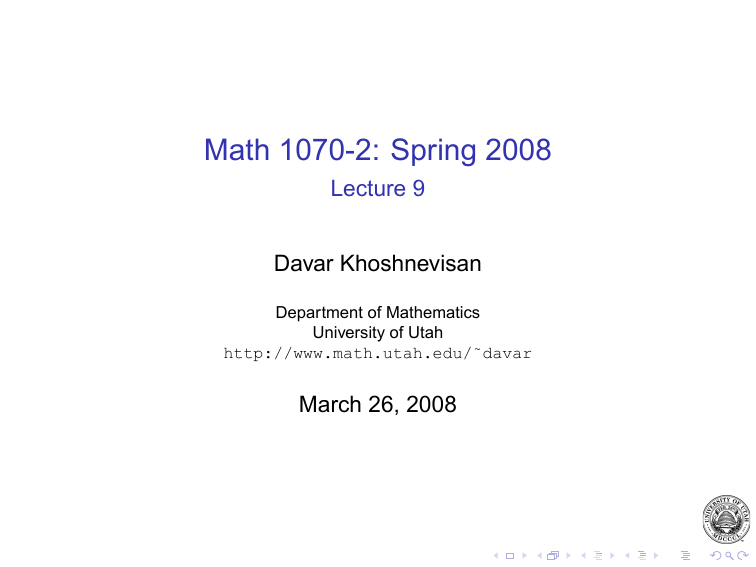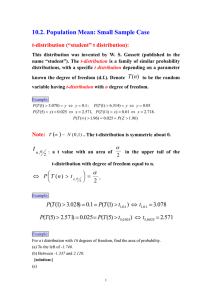Math 1070-2: Spring 2008 Lecture 9 Davar Khoshnevisan March 26, 2008
advertisement

Math 1070-2: Spring 2008 Lecture 9 Davar Khoshnevisan Department of Mathematics University of Utah http://www.math.utah.edu/˜davar March 26, 2008 Confidence intervals [recap] I A point estimate is a single number that is our “best prediction” for the parameter of interest. [Natural] I An interval estimate is an interval of numbers within which the parameter value is believed to fall. [Requires math] I Example: Avg. ht. was 70” in a random sample of size 100. Point estimate for the actual “population height” is 70 inches I Example: In a random sample of 500, 45% voted for Party X. Point estimate for the percentage of votes, in that population, for Party X is 45% I Goal: Given a certain percentage (say 98%), find a random interval that contains the parameter with probability at least that percentage. Confidence intervals for proportions [recap] I p̂ = “p hat” = sample proportion I Then, r p̂ ± (` × SE) = p̂ ± ` × p(1 − p) n ! I What is `? [for 95%, ` = 1.96; for 99%, ` = 2.58] I A good approximation: r p̂ ± ` × p̂(1 − p̂) n ! An example [recap] I A market survey organization took a simple random sample of 500 households in a certain town with 25,000 households: 79 of the sampled households had computers. Is it possible to find a 95% CI for the percentage of all 25,000 households with computers? I I I I You bet it is possible! p̂ = 79/500 = 0.158 [≈ 15.8%; point estimate for p] SE: r p̂(1 − p̂) SE ≈ ≈ 0.0163 n 95% CI for p: 0.158 ± (1.96 × 0.0163) = 0.158 ± 0.031948 I p is somewhere between 0.126 = 12.6% and 0.19 = 19% [95% confidence = ????] An example # 7.7, p. 321 I 1998 data: “Do you believe in heaven”? [n = 1158] I p̂ = 0.86 [proportion of “yes.”] I SE: r SE = I p̂(1 − p̂) = n r 0.86 × (1 − 0.86) ≈ 0.0102. 1158 95% CI for the proportion of “yes” for “heaven” p̂ ± (1.96 × SE) ≈ 0.86 ± (1.96 × 0.0102) ≈ 0.84 to 0.88. I What does this mean? I Aside: “MOE” here is 1.96 × 0.0102 ≈ 0.02. Confidence intervals at large I General philosophy: Confidence interval = point estimate ± margin of error I Example: For proportions [at 95%] r Confidence interval = p̂ ± 1.96 I p̂(1 − p̂) n “Therefore”: For means [at 95%] σ Confidence interval = x̄ ± 1.96 √ n I “Therefore”: For means with σ unknown but n large [at 95%] s Confidence interval = x̄ ± 1.96 √ n An example Example 6, pp. 334–335 I Recent GSS [General Social Survey]: “On the average day, about how many hours do you personally watch television?” I Some results (M INITAB): Variable TV I n 905 mean 2.983 SD 2.361 SE mean 0.0785 95% CI (2.83 , 3.14) Some questions: I I I What do the sample mean and SD suggest about the shape of the population distribution? How did the software compute stadard error? What does it mean? Interpret the 95% CI reported by the software. An example #7.25, p. 343 I 2002 GSS: “What do you think is he ideal number of children for a family to have?” I 497 women responded; median = 2; mean = 3.02; SD = 1.81 Point estimate of the population mean = ? I I I I 3.02 SE mean √ =? I 1.81/ 497 ≈ 0.0811 95% CI for the mean = ? I 3.02 ± (1.96 × 0.0811) = (2.86 , 3.17) [Note the text’s discrepancy] I Is it plausible that µ = 2? I No [95% sure] CI’s for means via the t-distribution I The problem: Find a CI for µ, as before: σ Confidence interval = x̄ ± z × √ n I If σ unknown but n large, then σ ≈ s with very high probab. Therefore, s √ Confidence interval = x̄ ± z × n I If n small, then hopeless in general . . . except I If the underlying population is normal, then s 95% confidence interval = x̄ ± t0.025 × √ n The t-distribution I The “t-distribution with (n − 1) degrees of freedom [df]” looks like the normal distribution I It is not a normal distribution, though I Tabulated in Table B [A3 in Appendix A] I The [Student’s] t-distribution was found by William S. Gosset [1876–1937; aka “Student”] in 1908 I Gosset was in charge of QC for The Guinness Brewing Company in Dublin © The t-table Examples I For a 95% CI: I I I I If n = 3, then df = 2 and t0.025 = 4.303 [ 1.96] If n = 10, then df = 9 and t − 0.025 = 2.262 [> 1.96] If n = 50, then df = 49 ≈ 50 and t0.025 = 2.009 [> 1.96] If n = 99, then df = 98 ≈ 100 and t0.025 = 1.984 [≈ 1.96] I What is going on? I What if we want a 99% CI, say? I Ans: Find t0.005 . An example #7.6, p. 321 I Starting salary for n = 3 recent math. grads from NCSU I Data: 45K, 35K, and 55K I Point estimate for the mean starting salary of all recent math. grads from NCSU: (45 + 35 + 55)/3 = 45K I SD of data = 10K I If salaries are ≈ normal, then a 95% CI is [df = 2] s 10 CI = 45 ± t0.025 √ = 45 ± 4.303 × √ ≈ (20.16 , 69.8) n 3 I How reliable is the point estimate? The normal assumption I The t-confidence interval is valid exactly only when the underlying population is ≈ normal I What if the underlying population is almost normal? I Good news: The CI is “robust” under slight deviations from normality I To check: plot the histogram, and think. I Bad news: None of our methods are robust [or any good, for that matter] under “nonrandom” sampling I Fact: If n is large, then the t-distribution is almost standard normal Choosing the sample size I Question: How big a sample size do we need in order to have a MOE of size m I For proportions, the MOE for a 95% CI [for p] is r p̂(1 − p̂) m = 1.96 n provided that n is large I I.e., 2 m = 3.8416 × I Solve: n = 3.8416 × I p̂(1 − p̂) n p̂(1 − p̂) . m2 General formula [p. 348], but you are expected to do this on your own in the final exam Choosing the sample size I For means, the MOE for a 95% CI [for p] is σ m = 1.96 √ n provided that n is large I I.e., 2 m = 3.8416 × I Solve: σ2 n σ2 n = 3.8416 × m2 I If this n is large and σ is not known, then s ≈ σ I General formula [p. 349], but you are expected to do this on your own in the final exam






